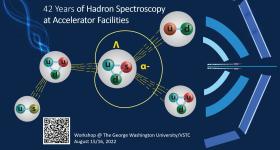Past Events

42 Years of Hadron Spectroscopy at Accelerator Facilities
Retirement Symposium for W. J. Briscoe
Monday, 8/15/2022, 9:00am - Tuesday, 8/16/2022, 12:00pm
Workshop on experimental techniques and applications in nuclear physics at JLab, MAMI, and other facilities - a review of the last 4 decades and an outlook to t
Norbert Linke, University of Maryland
Thursday, 4/1/2021, 4:00pm - 7:59pm
Join the GW Department of Physics for a colloquium with speaker Norbert Linke from the University of Maryland.
Marco Battaglieri, Jefferson Laboratory
Thursday, 2/18/2021, 4:00pm - 6:59pm
Join the GW Department of Physics for a colloquium with speaker Marco Battaglieri from the Jefferson Laboratory.
Paul Demorest, National Radio Astronomy Observatory
Thursday, 2/11/2021, 4:00pm - 6:59pm
Join the GW Department of Physics for a colloquium with speaker Paul Demorest from the National Radio Astronomy Observatory.
Cornelius Bennhold Lecture: “Why traditional labs fail (and what to do about it)”
Dr. Natasha G. Holmes, Asst. Professor of Physics at Cornell University
Thursday, 11/21/2019, 4:00pm - 6:59pm
The Gamow Explorer: A High Redshift Universe Gamma-Ray Burst Mission
Prof. Nicholas White, George Washington University
Thursday, 11/14/2019, 4:00pm - 6:59pm
Choreography in Nature, in Newtonian Gravity (living in motion)
Prof. Alexander Turbiner, Universidad Nacional Autónoma de México and Stony Brook University
Thursday, 10/24/2019, 4:00pm - 7:59pm
AstroAnimation: Bridging Two Cultures in the Post-Truth World
Dr. Laurence Arcadias, Maryland Institute College of Art and NASA GSFC & Dr. Robin Corbet University of Maryland, Baltimore County and NASA GSFC
Thursday, 10/17/2019, 4:00pm - 7:59pm
Dr. Crystal Bailey, American Physical Society
Thursday, 10/10/2019, 4:00pm - 7:59pm
Searching for X-Ray Binaries with Large-Scale Optical Variability Surveys
Prof. Eric Bellm, University of Washington
Thursday, 10/3/2019, 4:00pm - 7:59pm

